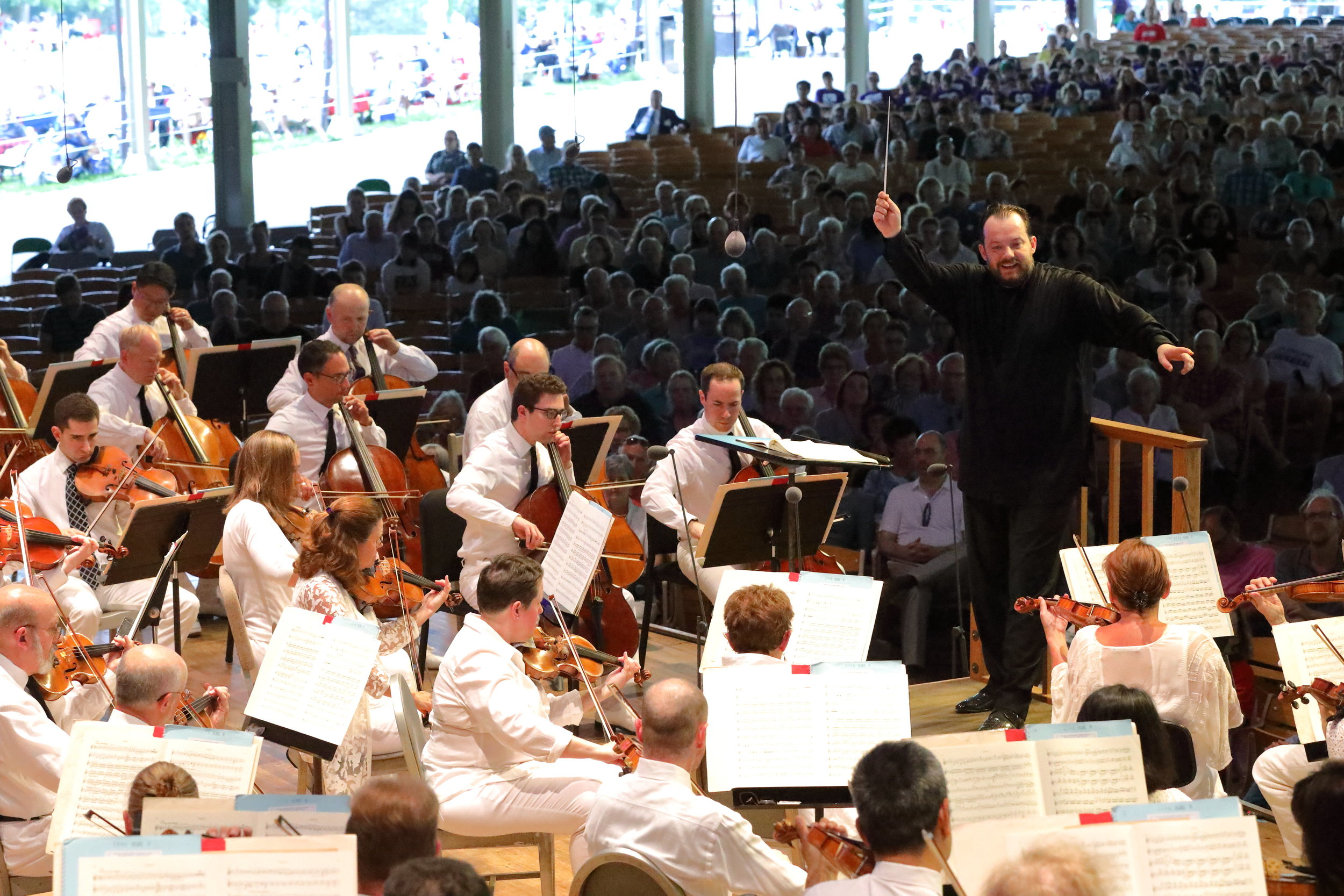Andris Nelsons conducts the Boston Symphony Orchestra at Tanglewood. Hilary Scott photograph
THE CONCERT PERFORMANCES of Die Walküre that the Boston Symphony Orchestra presented in the Shed at Tanglewood on July 27 and 28 were more master class than masterly Wagner: half-a-dozen of the leading Wagner soloists, along with BSO music director Andris Nelsons, took the stage with the Tanglewood Music Center Orchestra—the 150-odd fellows who seem to be able to play anything.
The relaxed schedule spread the three acts over two days. “Just enough Wagner,” was overheard. It also fit splendidly into the ancillary programming introduced at the BSO’s new Linde Center, the first new buildings at Tanglewood in decades.
The Tanglewood Learning Institute complemented these performances with artist discussions and lectures—perfect for can’t-get-enough Wagnerians.
Any concert presentation from Wagner’s Ring cycle sharpens the focus on the instrumental music, and on the splendid libretto. Still seamless and idiomatic after 150 years, Wagner’s narrative has characters who touch everyone by constantly singing believably and intimately to each other—even if they are gods. Tanglewood’s Brünnhilde, the estimable soprano Christine Goerke, was weeping at the climax of Act III—not acting, weeping.
Soprano Amber Wagner and tenor Simon O’Neill were the incestuous siblings Sieglinde and Siegmund, joining bass Franz-Josef Selig (Hunding) for Act I on Saturday evening. Goerke and mezzo Stephanie Blythe (Fricka) joined bass-baritone James Rutherford (Wotan) for Sunday’s matinee of Act II; Wagner, Goerke and Rutherford sang in the culminating act that evening, joined by the octet of Valkyries. Each of the three performances drew only modest houses by Tanglewood standards.
By almost any measure, there could hardly be a better assembly of Wagner soloists. Goerke provided a jolt of energy each time she took the stage. Rutherford sang with easy power through many wondrous, challenging moments. American soprano Wagner sang Sieglinde with impressive tone and strength, accented with facile vibrato. Blythe’s Fricka had appropriate authority in Act. II; she had to work hard through one long passage as the climate in the Shed shifted suddenly even hotter, clearly affecting everyone. It was only one of multiple challenges the singers faced. Blythe brought an earthy quality to the role, sounding forceful and determined.
O’Neill warmed up to his Siegmund in Act I, eventually singing the “Wehwalt” narrative with clarity and emotion. Selig supplied a visually and sonically typecast Hunding. The Valkyries, making their riotous appearance in Act III, brought collective enthusiasm to the performance.
It would have been the quintessential Tanglewood lawn experience, excepting the weather—plenty of volume, with subtitles and video, and no sets or props to miss out on. That said, this reviewer sat blissfully in the Shed, center-stage six rows back, directly behind the conductor. It was listener heaven; the climate, however, was everyone’s hell. Airless, humid and still, it had to affect the performers. Wagner’s penchant for physical demands—the Shed seemed to be channeling the amenity-free environment at Bayreuth—was certainly honored this weekend.
In the context of three discrete concerts, each act of Die Walküre takes on its own characteristics. Act I sits low. TMC fellow John Lee, principal cellist in that performance, played the first of many fine instrumental solos. Some of the horn playing could have benefited from a re-do, especially in Act II. Wagner’s horn and wind parts challenge every player—professional or student—and Act II had some textured, shifting rhythms in those sections that sounded as rough as the weather.
A thunderclap just before the first downbeat in Act III—as Wotan’s anger comes storming onstage—provided both a Tanglewood cliché, and an unexpected real-life complement. The culminating act sits as sonically high as Act I sits low. With the octet of Valkyries, Brünnhilde, and Sieglinde frequently onstage, leaving Wotan as the only male voice. Act III also offered a break with the complex ensemble parts written for the Valkyries, such as their “Hear Our Plea” to save Brünnhilde.
Wagner’s through-composed narrative drives ahead, even though it moves slowly. These veteran soloists adopted a conversational style, keeping their lines constantly streaming.
Nelsons worked less flamboyantly than usual, more symmetrically. That could have just be the length, and the heat (he was seated for most of the performance). More likely Nelsons was being purposefully direct for his instrumentalists. One can always find a downbeat with Nelsons, but here he coached more than usual. His trademark “ice-cream scoop” gestures were not evident—on a weekend that could have used a serving or two. —Keith Powers


